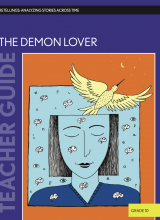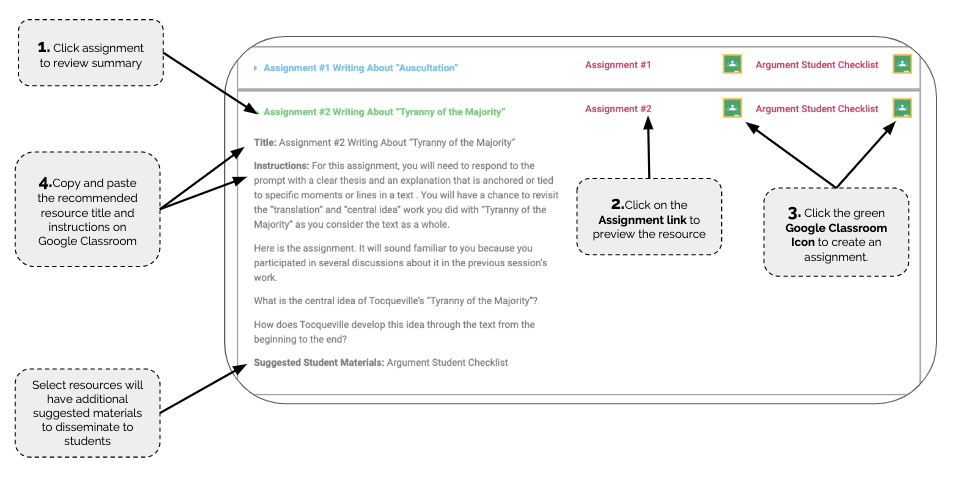The Demon Lover - Grade 10
Italian novelist Umberto Eco said, “Books always speak of other books, and every story tells a story that has already been told.” The Demon Lover is designed around that notion of retellings—the idea that authors draw on and transform stories that have already been told, and in the process, create new meanings. This unit is part of Inquiry By Design’s high school series, Retellings: Stories Across Time.
In this three-text unit, students have the opportunity to study two twentieth- century retellings of a traditional Scottish folk ballad called “The Daemon Lover,” alongside a study of the ballad itself. The first retelling students will read is by Anglo- Irish writer Elizabeth Bowen and is set in London in 1941. The second retelling was published eight years after Bowen’s short story and is by American writer Shirley Jackson. Students will read, interpret, write about, and discuss each text separately. They will also read, write about, and discuss the texts as a set, comparing their characters, sequences of events, and meanings. Finally, if the teacher chooses, students will continue on to write a retelling of their own.


Table of Contents
Writing Tasks
Title: Rereading Bowen’s “The Demon Lover”
Instructions:
Session 2
Title: Writing About Bowen’s “The Demon Lover”
Instructions:
As you’ve realized from your reading and rereading of “The Demon Lover,” this story is rather ambiguous. Many aspects of it—from individual words and phrases to the actual events—are open to multiple interpretations. Since its publication, multiple scholars have put forth their interpretations of the story based on careful and close readings of the text. Now it’s your turn.
Please reread “The Demon Lover” to come up with an interpretation in response to the question below.
Who—or what—takes Mrs. Drover away at the end of the story? |
Suggested Student Materials: Interpretive_Argument Checklist
Title: Rereading Jackson’s “The Daemon Lover”
Instructions:
Session 7
Title: Writing About Jackson’s “The Daemon Lover”
Instructions:
Like Bowen’s story, “The Daemon Lover” by Shirley Jackson has a great deal of ambiguity. You’ve already worked to interpret Bowen’s story. Now it’s time to try your hand at interpreting Jackson’s story. Essentially, your goal is to make sense of the many unanswered questions in the story by building a clear theory of “what is really happening,” then detailing and explaining the evidence that supports this reading.
Please reread “The Daemon Lover” and then write a 1- to 2-page response to the following question:
What is the clearest interpretation of the strange events in Shirley Jackson’s “The Daemon Lover”? |
Suggested Student Materials: Interpretive_Argument Checklist
Title: Messages in The Demon Lover Tales
Instructions:
Session 10
Give students about 20-25 minutes of individual time to reread the texts, study their notes and the class charts, and take notes in response to the “Messages in The Demon Lover Tales” assignment. If students need additional support, you might consider having them work in pairs or trios. As students are working, circulate around the room to provide support and assistance as needed and to get a sense of how students are doing.
Charts for Discussion
Title: Interpretations: Bowen’s “The Demon Lover”
Teacher Manual Instructions:
Session 3
When just a few minutes are remaining in the discussion, ask a student or two to summarize the major interpretations that have been developed along with the evidence to support those interpretations. Chart the interpretations and evidence for all to see. Title the chart “Interpretations: Bowen’s ‘The Demon Lover.’” Ask students what other interpretations or evidence they have to add to the chart. (See teaching note at the end of this session.)
Title: Retelling “The Daemon Lover” Ballad
Teacher Manual Instructions:
Session 4
When students are finished reading, have them get together with a partner and take about 5 minutes to discuss their responses to the comprehension questions.
Convene the whole group and engage students in a discussion of the comprehension questions. Again, keep the discussion brief and focused on the gist of the text.
Begin by asking students to retell what is literally happening in the ballad. Chart what students say. Label the chart “Retelling ‘The Daemon Lover’ Ballad.”
Title: Interpretations: Warnings to Married Women
Teacher Manual Instructions:
Session 5
With just a few minutes remaining, ask a student or two to summarize the major interpretations that have been developed along with the evidence to support those interpretations. Chart the interpretations and evidence for all to see. Label the chart “Interpretations: Warnings to Married Women.” Ask students what other interpretations or evidence they have to add.
Title: Retelling Jackson’s “The Daemon Lover”
Teacher Manual Instructions:
Session 6
Convene the whole group and engage students in a short discussion of the same comprehension questions. Begin the comprehension discussion by asking students to retell what is literally happening in the story. Chart what students say. Label the chart “Retelling Jackson’s ‘The Daemon Lover.’” Once again, when students mention a part that is ambiguous (i.e., they aren’t clear what’s happening or there might be multiple interpretations of what’s happening), mark that part with a question mark.
Title: Interpretations: Jackson’s “The Daemon Lover”
Teacher Manual Instructions:
Session 9
Convene the whole group. Explain that the next 20-25 minutes will be dedicated to a whole-class discussion of students’ interpretations of Jackson’s “The Daemon Lover.”
Checks for Understanding
Title: Retelling Bowen’s “The Demon Lover”
Teacher Manual Instructions:
Session 1
Convene the whole group and engage students in a short discussion of the comprehension questions.
Begin the comprehension discussion by asking students to retell the sequence of events. Their summary should include when and where this story is set. Capture what students say on a chart titled “Retelling Bowen’s ‘The Demon Lover’.” Encourage students to stick with what is literally happening in the story.
In order to encourage wide participation, you might call on one pair to begin the retelling and then move on to other pairs to continue the retelling until all pairs have contributed to the retelling of the entire story.
Title: Questions About “The Demon/Daemon Lover”
Teacher Manual Instructions:
Session 1
Finally, ask students what questions they have after reading this story. Capture their questions on a chart titled “Our Questions About the Icarus Tales.” This chart will be used to track the questions students have about all of the demon lover texts, which is the reason for the two spellings of demon.
Independent Reading
Title: Book Interview
Instructions:
Display a copy of the “Book Interview” sheet for the class to see and distribute copies to students.
Using one of the books from the classroom library, model for students how to interview a book and how to fill out the sheet. Answer any questions students have about the form and its terminology.
Give students time to interview three books and to enter their findings on the “Book Interview” sheet.
Title: Book Pass
Instructions:
Organize students’ desks into a circle (or, if this is not possible, determine a very clear path for books to pass through the group).
Explain the purpose of a book pass:
A book pass is another way to expose students to the texts available in the classroom library. A book pass requires students to use their book interviewing skills. A book pass is a chance for students to find titles to add to their “Books I’d Like to Read” list.
Display a copy of the “Book Pass” for the class to see and pass out copies to students.
Demonstrate for the class how a person goes about making an entry on the form. Since students will need to write quickly, show how an author can be listed just by last name and first initial, and demonstrate how a student can abbreviate a long title if necessary. What matters is that they have enough information to track down the book again later if they need to.
Give each student one book (or magazine). Tell them it doesn’t matter which text they start with, because they will see all—or at least many of—the books. (Be sure you have one title for each student in the circle.)
Choose a direction for passing.
After students receive a book, they should immediately record the author’s name (if the text is a book) and title on the “Book Pass” form.
Give students one minute to interview each book following the procedure established in the previous session.
At the end of one minute, call “pass.” At this time, students should make an entry in the comments column and pass the book to the next student.
Continue the book pass until each student has interviewed all the books.
Title: Book Recommendation
Instructions:
Distribute copies of the “Book Recommendation” form to students and give them time to craft or begin crafting their first review. Students can choose to write about a book they’ve completed recently or one they remember well from past reading.
Title: Goals for My Reading Life
Instructions:
Display a copy of “Goals for My Reading Life” for the class to see and distribute copies to students.
Use this time to review how to fill out the goals sheet. Be sure to show students how they can use the charts to generate ideas for answers to the “Goals” questions.
Take a moment to stress the value and function of the “Books I’d Like to Read” list. Point out that this list is a tool that serves the same function as a bedside table for some readers: It is a place to store up titles or books that are “next in line.” Remind the class that readers constantly have their eyes open for “next” texts. A “Books I’d Like to Read List” is a way to prevent aimless and unproductive castings around for new reading materials. It’s a planning tool.
Explain that at the beginning of each marking period, each student will fill out a new goals sheet; at at the end of each marking period, students will take a few minutes to review their goals statements and reflect on their efforts to meet them.
Answer any questions students have about the “Goals for My Reading Life” forms.
Give students time to complete the form and set a deadline for submission. You may decide to photocopy these to keep a set for yourself. Return the forms to students during the next session and have them attach the form to a page in their notebook or save it for their student portfolio (see Creating a Student Portfolio).
Title: Reading Log
Teacher Manual Instructions:
Show students how to set up a “Reading Log” in their notebook. They should be sure to enter it in their table of contents. You may decide to distribute sticky notes so that students can flag this page. Use the model on the next page to guide your efforts.
Notice the column titled “Date Completed/# of Pages Read.” This column is a place for students to record, and receive credit for, the reading of texts that did not require a “cover-to-cover” experience. Be sure to point out that reading sections of several texts for specific purposes is not the same as skipping aimlessly from book to book to book. The former often indicates purposefulness and interest; the latter can indicate confusion or disengagement.
After students have set up the reading log—including proper headings, creating the grid, etc.—demonstrate how to make an entry.
Answer any questions students have about the log.
Remind students that the reading log is a tool to be used in conjunction with the “Goals” sheets. Students track their reading in the log and then use the log to evaluate their progress toward their goals.
If you plan to use student portfolios this year, consider introducing them at this time using some version of the information in the section that follows. Review Creating a Student Portfolio in advance to be sure you have thought through some of the important questions for portfolio work.
Unit Resources
Title: Writing About Jackson’s “The Daemon Lover”
Title: Writing Across Texts: Messages in The Demon Lover Tales
Title: Grades 9 and 10 – Interpretive_Argument Rubric
Title: Grades 9 and 10 – Informational_Explanatory Rubric
Title: Scaffolds and Modifications: Descriptions and Use
